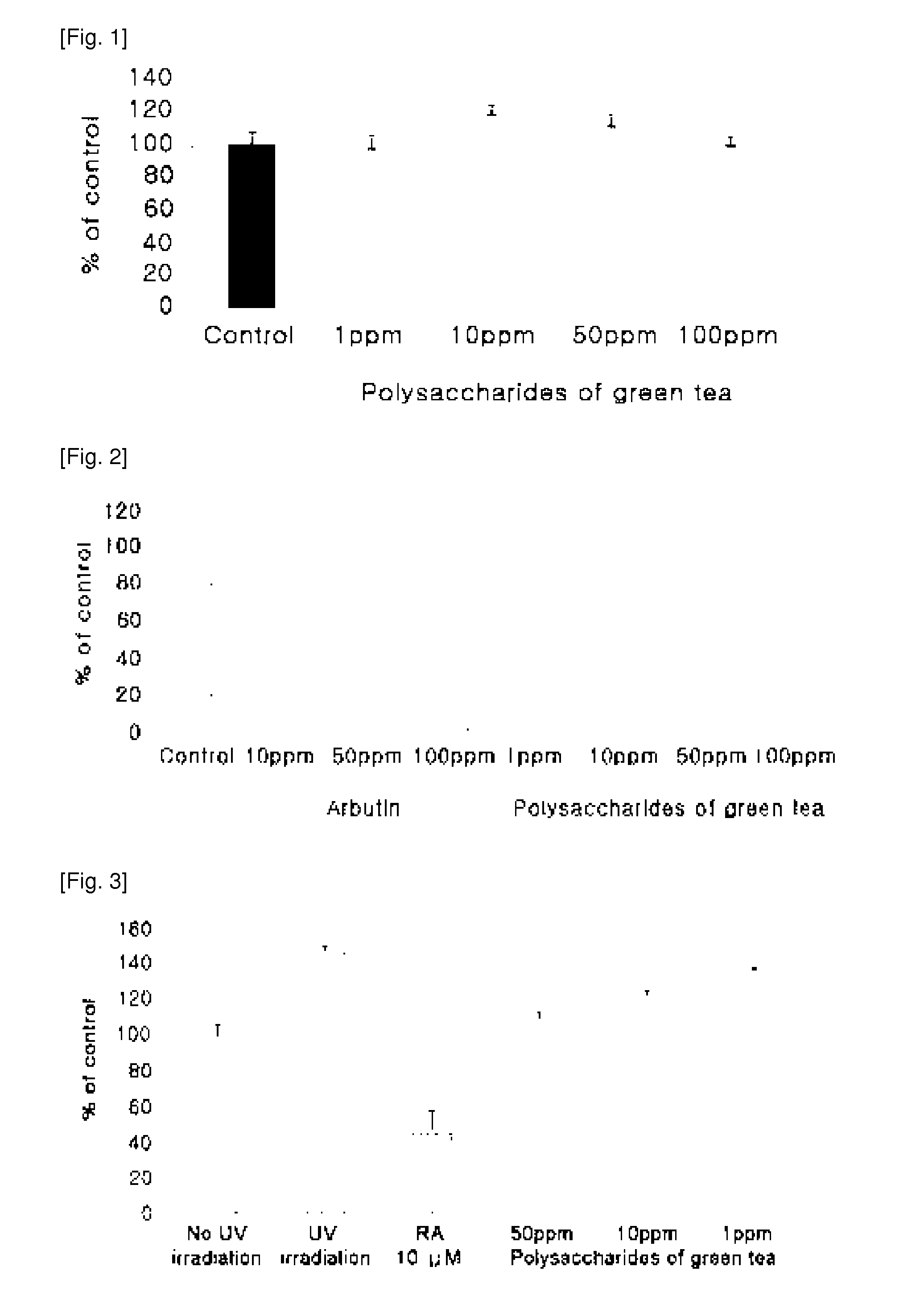Method for preparing polysaccharide of green tea and cosmetic composition for skin whitening, moisturization and Anti-wrinkle effects comprising the polysaccharide
a green tea and polysaccharide technology, applied in the field of green tea polysaccharide preparation, can solve the problems of inability to avoid the necessity of use of green tea extract, no mass production techniques have been established, and the economic efficiency of ion exchange and gel filtration chromatography processes is inferior, so as to improve the economic efficiency and reduce the production time , the effect of improving skin whitening, moisturizing and anti-wrinkle effects without skin irritation
- Summary
- Abstract
- Description
- Claims
- Application Information
AI Technical Summary
Benefits of technology
Problems solved by technology
Method used
Image
Examples
example 1
Preparation of Polysaccharide of Green Tea
[0047]Dried green tea leaves were pulverized and sieved through a screen to obtain green tea powder (d50=100˜1000 μm). 10 kg of the green tea powder was dispersed in 150 l of 95% (v / v) ethanol and stirred at room temperature. The mixture was centrifuged to remove chlorophyll and low molecular weight polyphenols. The residue was extracted once with the same solvent and dried.
[0048]The product of the extraction, from which the chlorophyll and low molecular weight polyphenols had been removed, was added to 125 l of water and stirred at 35° C. for 7 hours for hot-water extraction. The resulting extract of the polysaccharide of green tea was filtered through a filter press, collected and concentrated in vacuo at 62° C. to 1 / 10 of the initial volume.
[0049]The concentrate of the polysaccharides of green tea was ultrafiltered (molecular weight CUT OFF: 30,000 daltons) to remove low molecular weight protein isolates, and then subjected to the ethanol...
experimental example 1
Cytotoxicity Test
[0050]Human keratinocyte HaCaT cells were seeded in a 96-well plate, each well containing 1×104 cells, and cultured for 24 hours. The plate was washed once with 100 μl of PBS (phosphate buffered saline), exchanged with media containing 1, 10, 50 and 100 ppm of the polysaccharides of green tea, and cultured for 48 hours. WST-1 solution (Roche Diagnostic GmbH., Germany), diluted 10 times, was added to each well. The plate was incubated at 37° C. for 2 hours. Subsequently, the absorption at 450 nm of the resulting solution was measured. A control group used dimethyl sulfoxide to dissolve the sample. The data of the adsorption were corrected for the data of the control group and the result is shown in FIG. 1.
[0051]As shown in FIG. 1, it was noted that the samples containing the polysaccharides of green tea according to the present invention showed cell viabilities similar to the control group and did not have cytotoxicity or induce skin irritation in the used concentrat...
experimental example 2
Inhibitory Effect on Melanin Formation
[0052]In order to compare the inhibitory effect of the acidic polysaccharides of green tea on melanin formation in cells, this example was performed using arbutin, which is known as a melanin biosynthesis inhibitor, as a comparator. Melanin A cells were seeded into a 24-well plate, each well containing 3×104 cells. One day later, the wells of the plate were treated three times with either 10, 50 and 100 ppm of arbutin or with 1, 10, 50 and 100 ppm of the polysaccharides of green tea. After incubation at 37° C. for 3 days, the wells of the plate were again treated with arbutin or the polysaccharides of green tea by the same method as described above. After incubation for a further 3 days, the plate was washed with PBS. 1N NaOH solution was used to dissolve the formed melanin, and subsequently the absorption at 405 nm of the resulting solution was measured. The control group used dimethyl sulfoxide to dissolve the sample. The data of the absorptio...
PUM
| Property | Measurement | Unit |
|---|---|---|
| temperature | aaaaa | aaaaa |
| molecular weight | aaaaa | aaaaa |
| temperature | aaaaa | aaaaa |
Abstract
Description
Claims
Application Information
 Login to View More
Login to View More - R&D
- Intellectual Property
- Life Sciences
- Materials
- Tech Scout
- Unparalleled Data Quality
- Higher Quality Content
- 60% Fewer Hallucinations
Browse by: Latest US Patents, China's latest patents, Technical Efficacy Thesaurus, Application Domain, Technology Topic, Popular Technical Reports.
© 2025 PatSnap. All rights reserved.Legal|Privacy policy|Modern Slavery Act Transparency Statement|Sitemap|About US| Contact US: help@patsnap.com


